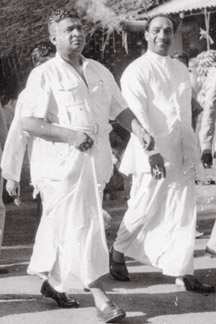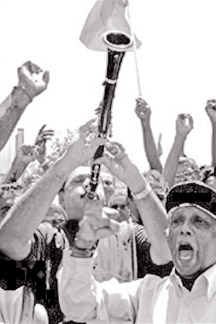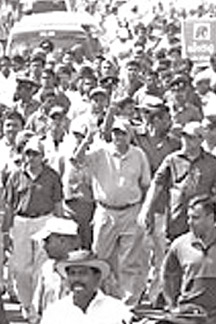|
Pada Yatras were once ‘marches for freedom’ led by
Mahatma Gandhi, but today…:
Power walking
by Uditha Kumarasinghe
Towards the early 1990s, the
existing UNP Government was beset with internal conflicts of its own and
the LTTE terrorism. During this period, new SLFP leaders, prominently
Mahinda Rajapaksa launched a successful Pada Yatra, Jana Gosha (Noise
Protest) and White Flag Campaigns against the then UNP Government
 |
|
Pada Yatra by UNP in 1957 |
‘Pada Yatras’, as practised by Mahatma Gandhi against the British authorities
in India was a political weapon of non-violence, though at times, brawls and
skirmishes took place among its supporters and opponents. Sri Lanka had its
first experience when UNP stalwart J.R.Jayawardena led a ‘Pilgrims March’ in
1957 to Kandy, to protest against the Bandaranaike-Chelvanayakam Pact despite it
being called off half way at Imbulgoda from where hailed ‘Imbulgoda Weeraya’,
the one time Mao disciple S.D. Bandaranaike. Youthful politician Mahinda
Rajapaksa led his historic Pada Yatra to Kataragama to protest against the
1988-89 killings and the political unrest in the country. The UNP’s Jana Bala
Meheuma of 2001 was launched against the rising cost of living and demanding
free and fair elections in the future. The so called Joint Opposition
(JO)-organized Jana Satana Pada Yatra to be held on July 28 hopes to mobilise
the masses against the sky rocketing cost of living and demand early Local
Government Elections. Pada Yatras which take different forms at different times
could at their best exert some influence on the Government but no tangible
results could be seen in their immediate aftermath.
The first Pada Yatra, euphemistically called ‘Pilgrims March’ in the political
chronicles of the country to protest against the Bandaranaike-Chelvanayakm Pact
was launched by the UNP on October 3, 1957 led by J.R. Jayewardena and other UNP
stalwarts from Colombo to Kandy. Former Prime Minister Dudley Senanayake was in
the forefront. Brawls occurred at the beginning of the Pada Yatra until it
reached Kadawatha town, 10 miles from Colombo. Kadawatha was a typical
battleground where many were reported to have sustained injuries. “Saboteurs
attacked us and the Police didn’t intervene apparently due to the Prime
Minister’s instructions. We have reached Kadawatha and our destination is Kandy.
We want the Government to withdraw the Bandaranaike-Chelvanayakam Pact,” said
J.R.Jayewardena as reported in the Dinamina on October 4, 1957.
MR’s Jana Gosha
 |
|
Jana Gosha spearheaded by
Mahinda Rajapaksa in 1992 |
Towards the early 1990s, the existing UNP Government was beset with internal
conflicts of its own and the LTTE terrorism. During this period, new SLFP
leaders, prominently Mahinda Rajapaksa launched a successful Pada Yatra, Jana
Gosha (Noise Protest) and White Flag Campaigns against the then UNP Government.
Sri Lanka’s largest and historic march (Pada Yatra) spearheaded by Mahinda
Rajapaksa similar to those launched by freedom fighters such as, Mao tse Tung
and Mahatma Gandhi commenced from Viharamahadevi Park, Colombo on March 16, 1992
and reached its destination, the sacred city of Kataragama on April 2, 1992. The
18-day Pada Yatra was launched to protest against: the UNP Government’s
privatization policy, a commission of inquiry and compensation for the
disappearances in the South, rising cost of living and a negotiated settlement
to the North- East conflict. Mahinda Rajapaksa became a prominent figure in the
political arena following the Pada Yatra from Colombo to Kataragama. However , a
majority of the Sri Lanka Freedom Party members did not back the Pada Yatra.
Mahinda Rajapaksa, Vasudeva Nanayakkara and Mahinda Abeykoon had walked the full
180 mile distance from Colombo to Kataragama. No matter how oppressive the
Premadasa regime was at the time, yet, it didn’t deploy the Police to stop the
18-day Pada Yatra, fire tear gas nor deploy any Government sponsored thugs to
break up the protest. Unlike today, there was no attempt to obtain a court
order. Neither Police nor Army road blocks were used.
Meanwhile,the SLFP also organized a Jana Gosha (Noise Protest) on July 1, 1992
and Mahinda Rajapaksa led the protest in several key cities, towns and villages
which at the end culminated in a regime change. A Pada Yatra from Matale to
Kandalama organised by a group of SLFP MPs on July 11, 1992 defying the ban on
processions was a flop due to a lack of public response.
Mrs B’s Human Chain
In addition, the first links of the Human Chain were forged at Siri Perakumba
Pirivena, Etul Kotte on November 13, 1992 led by Party Leader Sirimavo
Bandaranaike forming the first links. The Human Chain, a three day protest
demonstration against Government policies was extended along the 62-mile route
to Ratnapura. It hoped to garner the participation of over a lakh of people who
joined to make a vow to God Saman, seeking relief from the burdens and
difficulties confronting them. The SLFP also organized a Pada Yatra from
Horagolla to Colombo on January 16 and 17, 1993 in response to a request made by
six constituent parties. Nearly 15,000 party supporters took part in the two-day
march to mark the 37 th anniversary of the cultural revolution launched by the
SLFP founder S.W.R.D. Bandaranaike.
 |
|
Jana Bala Meheuma by UNP in
2001 |
The UNP launched a week-long Pada Yatra campaign Jana Bala Meheuma from Kandy to
Colombo on February 4, 2001 in a bid to force the immediate resignation of the
Government if it cannot bring down the cost of living, resort to good governance
and conduct future elections in a free and fair manner. The protest starting
from Getambe in Kandy stopped at Mawanella, Galigamuwa, Weweldeniya, Yakkala and
Peliyagoda before it finally reached Colombo on February 9, 2001. It attracted
tens of thousands of people from all walks of life and reached its destination,
Colombo Town Hall on February 9, 2001.
UNP’s Jana Bala Meheuma
The Jana Bala Meheuma was described by the party stalwarts as a very successful
peaceful agitation similar to the people’s power in the Philippines. However,
Pada Yatra activists came under attack by goons in Kegalle on February 5 despite
the then President Chandrika Bandaranaike Kumaratunga’s appeal to party men not
to unleash violence on the protesters. Two youths sacrificed their lives, being
victims of a brutal crackdown by the Government, but they signified it as
martyrdom, as they laid down their lives for the party and for the country.
Several top level leaders of the then Government also defected to the UNP and
UNP Leader Ranil Wickremesinghe made the dreams of the party come true by
winning the 2001 General Elections.
In mid December 2004, the UNP organized yet another protest march from Kandy to
Colombo calling upon the Government to release jailed UNP National Organizer S.B
Dissanayake. The protest march that originally commenced from Dissanayake’s home
town, Hanguranketha reached Hyde Park in Colombo along with several other
processions on December 21, 2004.
The marchers and Dissanayake’s colleagues offered poojas at temples and kovils
along the way calling upon the Gods to save him. The rally held at Hyde Park
concluded with women from Hanguranketha offering poojas and cursing the
Government. A bench of five judges sentenced Dissanayake to two years
imprisonment on charges of making a contemptuous statement at Habaraduwa on
November 3, 2003 where he poured scorn on the court by referring to its decision
as a ‘Balu Theenduwa’.
JO’s Jana Satana Pada
After a lapse of over a decade, the UPFA dissidents who claim themselves as the
Joint Opposition are planning to launch a massive Pada Yatra from Kandy to
Colombo on July 28 marking yet another milestone in the annals of Pada Yatras in
the country. The Jana Satana Pada Yathra will take the form of a national
movement and kick off opposite the Sri Dalada Maligawa, Kandy on July 28 at 9.30
a.m. under the patronage of former President Mahinda Rajapaksa.
The so called Joint Opposition expects millions of people to join the march
aimed at expelling the incumbent Government which they claim has no
understanding of the present plight of the people. The four-day Pada Yatra hopes
to reach Colombo on August 1. It expects to end the first day in Mawanella,
second day in Nelumdeniya and third day in Nittambuwa.
The participants will reach Kiribathgoda on the fourth day and will conclude on
the fifth day with a public rally in Colombo. All political parties in the so
called Joint Opposition will participate in it which focuses public attention on
several key issues, such as, the breakdown in good governance, indefinitely
postponing Local Government Elections and the unbearable escalation of the cost
of living.
Former President Mahinda Rajapaksa with other civic organizations, the public
who have been affected by VAT, government servants whose jobs were at stake,
doctors, engineers, and professionals who oppose the Economic and Technological
Cooperation Agreement (ETCA) with India.
A special committee has been appointed to organize the Pada Yatra and rallies
will be held in Nelumdeniya, Mawanella, Nittambuwa and Kiribathgoda However, the
SLFP MPs in the ruling coalition have already said that the SLFP would not
support the Pada Yatra against the Government and no SLFP parliamentarian has
intimated that he would join the protest march scheduled to start from Kandy on
July 28. |

